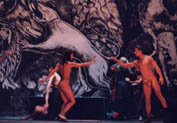OPERNSUCHE

Bomarzo
(1966-67)Libretto by Manuel Mujica Láinez (S,E,G)
S,M,A,AorT,T,Bar,B,child speakers,mime,dancer; chorus
2(II=picc).2(II=corA).2(II=Ebcl,bcl).2(II=dbn)-3.3.3.0-timp.perc(3): xyl/bells/3crot/3susp.cym/bongos/laiiro/5cowbells/tamb/
2thin metal sheets/small wood windchimes; glsp/3tgl/3tam-t/5tom-t/5tpl.bl/tamb/jingles/whip/medium wood wind chimes; bells/8small susp.cym/3low Chinese gongs/2SD(one without snare)/TD/BD/5wdbl/tamb/large wood wind chimes/ratchet/hyoshigi-
hpd-pft(=cel)-mand-harp-strings(principal viola=viola d'amore,
principal cello=viola da gamba)
Abkürzungsverzeichnis (PDF)
Boosey & Hawkes
Lisner Auditorium, Washington, DC
Tito Capobianco, director
Dirigent: Julius Rudel
Ensemble: Opera Society of Washington
| PIER FRANCESCO ORSINI, Duke of Bomarzo | Tenor |
| SILVIO DE NARNI, Astrologer | Baritone |
| GIAN CORRADO ORSINI, Father of Pier Francesco | Bass |
| GIROLAMO, Brother of Pier Francesco | Baritone |
| MAERBALE, Brother of Pier Francesco | Baritone |
| NICOLAS ORSINI, Nephew of Pier Francesco | Contralto or Tenor |
| JULIA FARNESE, Wife of Pier Francesco | Soprano |
| PANTASILEA, Courtesan | Mezzo-Soprano |
| DIANA ORSINI, Grandmother of Pier Francesco | Contralto |
| Messenger | Baritone |
| Pier Francesco, Girolamo, and Maerbale as children | Voices of reciting children |
| Abul, Slave of Pier Francesco | Mime |
| Skeleton | Dancer |
| Prelates, Courtiers, Pages, Servants, and Astrologers | Chorus |
16th Century, Bomarzo, Italy
The Duke of Bomarzo drinks a magic potion that his astrologer Silvio de Narni claims will make him immortal. Instead, it is a fatal poison. As he dies, the stunted hunchback Bomarzo relives his tortured existence through a series of flashbacks. His father drags him into a haunted room where a large skeleton dances and menaces him. Later, his father is mortally wounded in battle. The young man, still a virgin, is sent to the courtesan Pantasilea in Florence, but the reflection of his horrid image in her room of mirrors disturbs him. His brother Girolamo falls from a cliff and dies. The new Duke meets Julia Farnese, but is angered when she prefers his brother Maerbale. In a macabre dance festival, erotic and terrifying dreams pass before the Duke. Still courting Julia, he spills a glass of red wine on her dress and interprets it as a premonition of death. After their marriage, Bomarzo finds himself impotent. As years go by, he becomes convinced that Julia is unfaithful with Maerbale. He orders his slave Abul to kill his brother. Silvio mixes the magic potion while Bomarzo’s nephew Nicolas watches. The boy poisons the drink. Bomarzo drinks it and dies.
“Near Viterbo, Duke Piero Francesco Orsini, himself physically deformed, built a garden of monstrous statues that inspired Mujica Láines to create his monumental novel Bomarzo, from which he crafted an opera libretto for the greatest Argentine composer… Alberto Ginastera composed a powerful opera with an aesthetic of stark expressionism that is highly expressive, with moments of huge and rich sonic substance…"
El Mundo
“Bomarzo is a retrospective account before the death of the duke, who believes he has drunk a potion for immortality. In these moments the action visits key episodes that forged his life, marginalised by his deformity but also pursued by his own demons… The duke sits, locked in his labyrinth, twinned with the Minotaur, and sings in a search for answers… There are elements of Edvard Munch and also of Franz Kafka, with those unclassifiable monsters that prowl the stage. Bomarzo is an elixir of sounds and pictures that scream and scratch at a perennial human trait: solitude.”
La Nación
Dramatic, Tragic
